Amano shrimp (Caridina multidentata) is one of the best and most useful freshwater shrimps for keeping in a tank. This shrimp is irreplaceable in a tank since it can clean it by eating algae. Amano shrimp are popular choices for planted tanks and aquascapes, adding beauty and functionality to the setup.
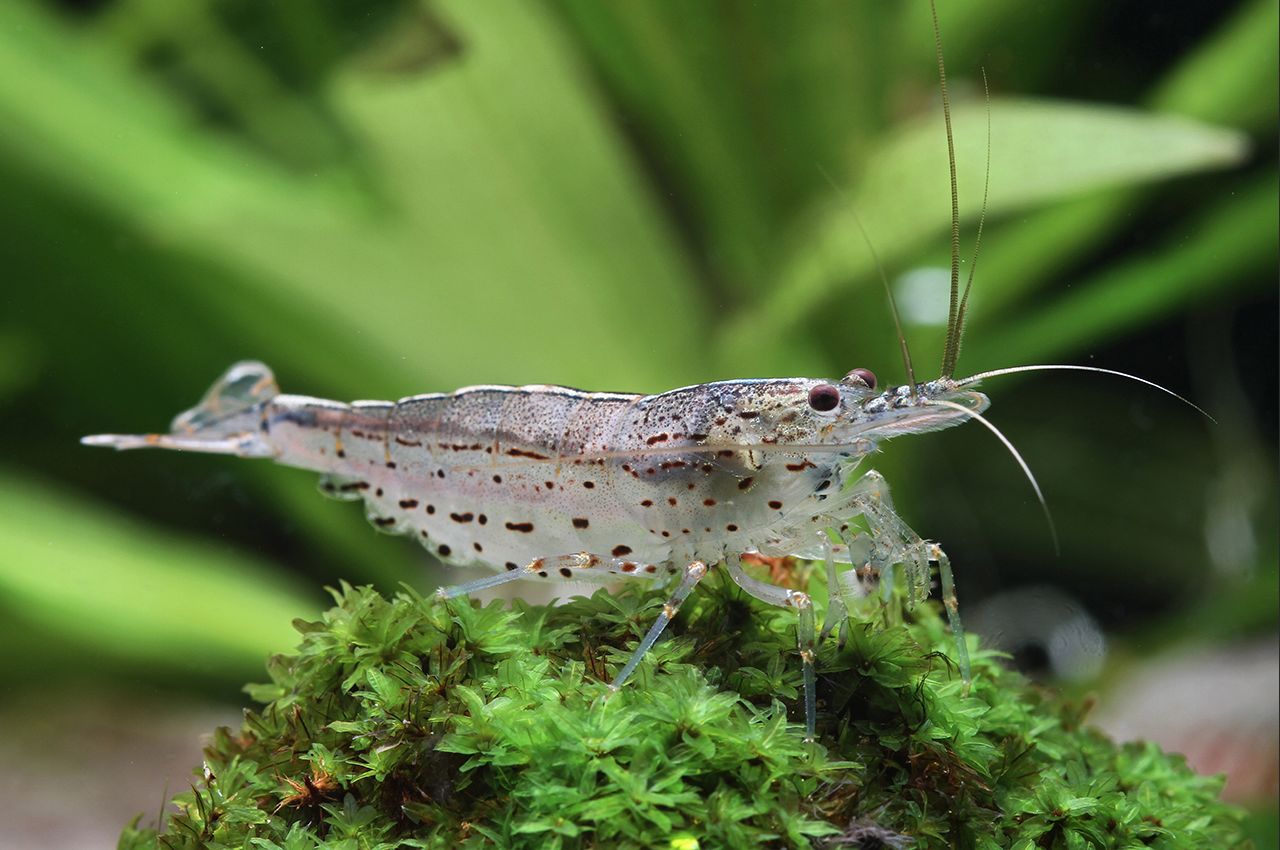
Contents
Shrimp Habitat in the wild
In 2006 due to some new studies of Japanese shrimps, it was determined that Caridina japonica (discovered and described in 1892) and Caridina multidentata (described earlier in 1860) – are the same kind. Thus, since 2006 the name was officially changed to «Caridina multidentata».
Takashi Amano, a famous aquascapist and designer of so-called “nature aquariums,” was the first to use these shrimps to deal with algae in his planted tanks. After revealing their remarkable ability to eat algae, he ordered several thousands of shrimps from the local seller. Since the 1980-s, aquarists started to call this shrimp “Amano shrimp.”
Wild Amano shrimp habitat is in the South of Central Japan, in South China, and recently it has been found in Taiwan. These shrimps inhabit clean freshwater rivers and streams flowing from the mountains into the ocean. Seawater plays quite a special role in the shrimp life cycle. The thing is that only adult shrimp dwells in freshwater bodies, but larvae hatch in the sea and feed on sea plankton. When the larvae grow a bit, it comes back to the freshwater rivers. This is actually the reason why Amano shrimp breeding in tanks has several difficulties.
In their natural habitat, Amano shrimp face predation from various aquatic organisms, including fish, birds, and larger invertebrates. Their translucent bodies and coloration patterns help them blend in with their surroundings, providing some protection against predators.
Description
Amano shrimp size is larger than that of a cherry shrimp. Males are 1.5 inches large (3-4 cm), female shrimps are 2 inches large (5-6 cm). Coloring is transparent in general, with tiny red-cinnamonic spots (about 0.3 mm in diameter). Depending on the shrimp diet, the color of its body may vary. For example, if Amano shrimp feeds mainly on algae and detritus, they have a greenish tint. However, when feeding the shrimp only with fish food, they get reddish coloring.
Amano shrimp have a unique and captivating appearance. Their bodies are elongated and cylindrical, and they have a pronounced curved rostrum or nose. The body of Amano shrimp is mostly translucent, with a distinctive brown or greenish coloration, which allows their internal organs to be partially visible. They have fascinating brown or greenish markings that create an intricate pattern on their bodies, including stripes, spots, and speckles.
At that, shrimp has an amazing ability to mask in a tank. If your shrimp has decided to hide, it’ll not be easy to find it. There are some cases when owners, when being sure that all the shrimps in the tank died, start washing it, and after draining all the water from the tank, they surprisingly find all the shrimps safe and sound on the tank bottom.
By the way, here is a piece of advice in this respect – if you want to find the shrimps hidden in the tank, direct the flashlight onto the tank bottom at night – the shrimps’ eyes will reflect the light and shine brightly.
Amano shrimp have long, slender antennae that help them navigate their environment and detect changes in their surroundings. They also possess delicate, branching appendages called pleopods that aid in swimming and egg-carrying for females.
How fast do amano shrimp grow?
Amano shrimp have a relatively slow growth rate compared to some other freshwater shrimp species. On average, it takes them around 6 to 12 months to reach their adult size, which is approximately 2 inches (5 centimeters) in length. However, it’s important to note that individual growth rates can vary based on factors such as genetics, diet, water conditions, and overall care.
During their growth period, Amano shrimp undergo a series of molts, shedding their old exoskeletons to accommodate their increasing size. After molting, they may appear temporarily softer and more vulnerable until their new exoskeleton hardens. Growth can be more noticeable during these molting periods.
| Characteristic | Description |
|---|---|
| Scientific Name | Caridina multidentata, Caridina japonica |
| Common Name | Amano shrimp, japonica shrimp, yamato shrimp |
| Origin | Japan and Taiwan |
| Size | Approximately 2 inches (5 centimeters) in length |
| Coloration | Translucent body with brown or greenish markings |
| Behavior | Peaceful and social, often found in groups or colonies |
| Lifespan | Around 2 to 3 years in captivity |
| Diet | Algae, detritus, decaying plant matter, and small invertebrates |
| Molting | Shed their exoskeleton to grow a new one |
| Breeding | Challenging in home aquariums due to complex larval stages requiring brackish water |
| Compatibility | Generally compatible with a wide range of tank mates |
| Aquascaping | Suitable for planted tanks and aquascapes |
| Water Parameters | Neutral to slightly alkaline pH, moderate hardness |
| Temperature Range | 70°F to 80°F (21°C to 27°C) |
| Lighting | Moderate to low lighting preferred |
| Tank Size | Can be kept in aquariums as small as 5 gallons |
| Predation | Vulnerable to predation by fish, birds, and larger invertebrates |
| Environmental Role | Controls algae growth, recycles nutrients, and serves as a food source |
Amano shrimp – algae eating shrimp
It was the shrimp diet that made it so popular among aquarists. Takashi Amano kept them in his tanks due to their ability to eat algae, which didn’t let him create his perfect aquascapes. In tanks, Amano shrimps perform their specific and useful job – they eat filamentous alga. With their small chelae, they eat it piece by piece and free a tank keeper from the necessity of fighting this alga.
Amano shrimps perform their very important job faultlessly. They eat green hair algae and other algae on tank plants, moss, tank decorations. Green hair algae actively propagate in the same conditions that decorative tank plants and quickly inlace the whole tank with the thin filaments.
Of course, no one likes this, but the task of removing all the algae from the tank with your hands … this is a hellish toil that is totally useless at the same time since, in a month, the algae will grow again. This is when the shrimps come to help. Unlike algae-eating fishes, it is difficult for the shrimps to scrape the algae from tank walls, plant leaves, and other tank surfaces. However, the deal very well with the filamentous alga
The shrimp uses its small legs with tiny “fan-jig-saw” to cut a piece of green algae, eat it, and then cut another portion, this way releasing the tank owner from the routine job of keeping the tank clean. In fact, Amano shrimp together with otocinclus is the only way to fight green hair algae actively in an aquascape.
To make the shrimps efforts to clean the tank maximum efficient, their population in the tank should be at least 4 species for 20 liters of water.
But Amano shrimp doesn’t feed on black beard algae and brown algae! The main task of this shrimp in the tank is to eat green hair algae. That’s why you shouldn’t expect to get rid of black beard algae once you put about dozen Amano shrimps in the tank. Moreover, even a hundred hungry shrimps are quite unlikely to help you in this case. Well, they will nip black beard algae from time to time, but eating it completely – never gonna happen!
For this reason, other algae-eaters must be present in a tank, and they should be capable of dealing with black beard algae and brown algae. For example, SAE fish can eat black beard algae, while algae eaters such as bristlenose pleco, Chinese algae eater, or nerite snail can deal with brown algae well.
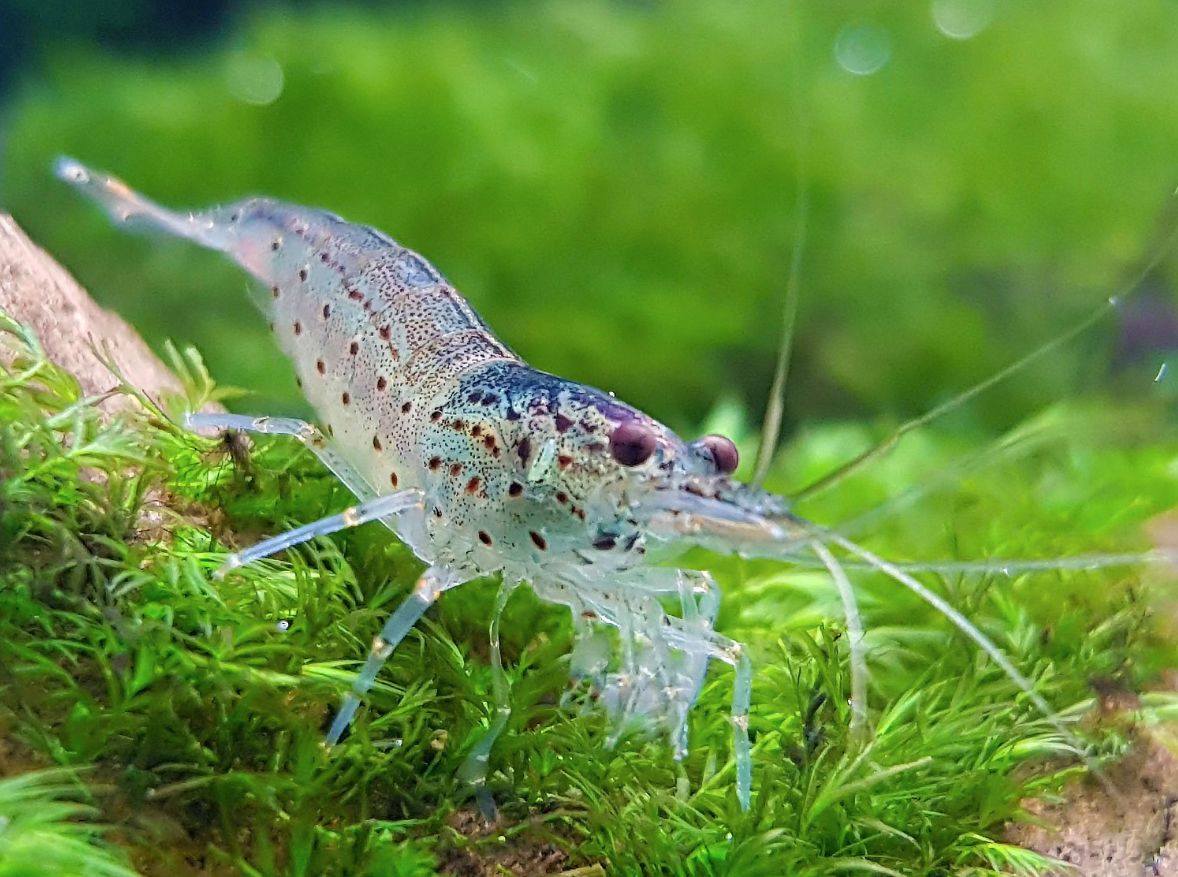
Difficulties in keeping
Amano shrimps are good for keeping in a tank, undemanding, not dangerous for fish, and eating all types of food. Since they prefer a company of their kind to keep them in a tank successfully, there should be at least 10 species in the group. The only important condition is that tank water parameters should be stable since it is often the case when Amano shrimp dies after the water change.
After starting a new tank, you can put shrimps in it not earlier than the 2nd week – when the biological balance and pH level are already stable, biological filtration starts working, and the CO2 supply is organized.
Care and keeping in a tank
Lifespan
The lifespan of Amano shrimp (Caridina multidentata) can vary depending on various factors, including the quality of care, water conditions, and genetics. On average, Amano shrimp have a lifespan of around 2 to 3 years in captivity. However, in extremely favorable conditions, they may live up to 5 years. Unfortunately, sometimes they die right after being bought or after the water change, but this is due to the stress and change of tank conditions.
Tank size
Tank volume for Amano shrimps is selected depending on their number. The recommended ratio is not less than 5 liters for one shrimp. The tank should be covered, and all large holes must be closed to make sure the shrimps won’t escape.
You can keep about 20 Amano shrimps in a tank of 25 gallons capacity which is thickly planted and has a small-grained bottom. Shrimps like the company of their kind. So if you keep more than 10 species in a tank, you’ll be able to observe how interestingly they cooperate with each other.
Water parameters
Amano shrimps are relatively undemanding to tank conditions – water parameters may vary significantly. The main thing is to avoid abrupt changes in the parameters.
Can Amano shrimp live in brackish water? No! This is totally freshwater shrimp, and only when breeding they live in brackish water and then get back to freshwaters.
Tank water temperature optimal for Amano shrimp is 73-82 °F (23-27 °C). However, the shrimp can live at 86 °F, and they easily stand tank water temperature decrease up to 60 °F (14-16 °C). Though at high temperatures, the shrimp metabolism rate rises, and it causes faster aging.
Tank water pH may vary from 5.8 to 7.0. If tank water pH value is higher than 7.5 and there is a lack of oxygen, shrimp doesn’t feel well and tries to get out of the tank water. Unlike other shrimps, Caridina multidentata isn’t very sensitive to ammonia content in the water.
Water renewal in a tank with shrimps should be performed weekly at about 20-30% of the total volume. After this, the shrimps usually become more active. The water you add can be 2-3 °C colder than the one in the tank. An insignificant decrease in the tank water temperature after its renewal stimulates the shrimps to breed.
Tank setup: decorations and plants
Shrimps, especially females, will be very glad to find some shelters in the tank – snags, small branches, tank plants with large leaves will do perfectly well. Female with eggs is very attractive for active male shrimps, and they haunt them rather aggressively. Therefore, you should provide the female shrimps with the ability to hide somewhere from their obstinate admirers.
Tank plants with small leaves will look nice and appealing as well. Java moss, christmas moss, flame moss, dwarf hairgrass, blyxa japonica, egeria densa, marimo moss balls, vallisneria are good choices for a shrimp tank. These plants are an ideal place for small tank dwellers to hide, and they accumulate food for them as well. Lots of suspended particles, mud, food leftovers settle there and then become home for algae.
Amano shrimps, especially young ones, love eating all the food mentioned above. Java moss creates perfect conditions for microorganisms to live (those that feed on bacteria). Water sprite will be another good choice for such a tank as well. This plant isn’t demanding as for the tank lighting, and its root system is very similar to that of the moss.
You must be careful when cutting the plants and removing them from the tank. Since together with them you can throw away a shrimp sitting on it.
The same situation may occur when weeding fluctuant on the tank water surface (amazon frogbit, water lettuce). Amano shrimps often sit on the leaves bottom.
Filtration
A perfect option for keeping and breeding shrimps is a tank with a canister filter. It ensures efficient filtration, and inside the filter, in time, a lot of waste accumulates there, which serves food for many useful bacteria. They clean the water and stabilize the tank ecosystem. In the case of a small-sized tank, you can use an internal filter.
Why did my Amano shrimp die?
- Improper transporting may cause the shrimps’ stress and shock. Such a situation occurs when the volume used for transporting the shrimps has nothing for them to hold on. Therefore, when transporting them over large distances, you should put some moss or pieces of foam in the package with the shrimps.
- Don’t perform the preventive treatment or cure fishes in a community tank since many medicines contain copper compounds, namely sulfate of copper (CuSO4). When copper concentration in the tank exceeds the acceptable level, the shrimps die. For the same reason, don’t let liquid fertilizers overdose in the tank since they also may contain copper.
- Putting the shrimps into a tank without acclimation. You should gradually get them adapted to new conditions gradually since they are sensitive to abrupt changes of the latter. To do so, you should renew the water in the transporting volume during 2-3 hours by adding small portions of tank water. If you don’t do this, the chances are high that the shrimps will die in a day due to the shock.
- Abrupt change of water parameters when keeping the shrimps, especially pH level, ammonia concentration (NH3, NH4) in a best-case scenario will cause extra shedding of the shrimps; in the worst-case – they die. At first, after washing the filter, ammonia concentration rises, and they are very sensitive to it. To avoid such a situation, you shouldn’t wash more than 1/3 of the filtering material. The best way is to wash only the filler of the mechanical cleaning section.
- Oversaturation of the water with carbon dioxide gas (CO2) also negatively impacts the shrimps health since crustaceans are more sensitive to CO2 excess than fish. When supplying carbon dioxide gas to a planted tank, it is recommended to observe the shrimps behavior. When CO2 concentration is high, they become less active and stop gathering food.
- Lack of calcium in the water may also cause the shrimps death. Usually, it is seen during or right after they stop shedding. When using osmosis in the tank, you should mix it with tap water in proportion 4:1 or increase the water hardness using chemicals.
- Lack of oxygen may also affect the shrimps state. Its deficiency is one of the reasons for their death.
- Hungry shrimps quickly die. Ideally, they should feed all the time.
- Another usual reason for shrimps death is poisoning with chlorine. When changing the water in a tank, it is important to understand that tap water can contain chlorine and chloramine as well, which, unlike chlorine, doesn’t evaporate from the water after settling and aeration. If its concentration in the water is high, the shrimps may die. Not to endanger them, use special conditioners to prepare water. They usually contain sodium thiosulfate that destroys chlorine components.
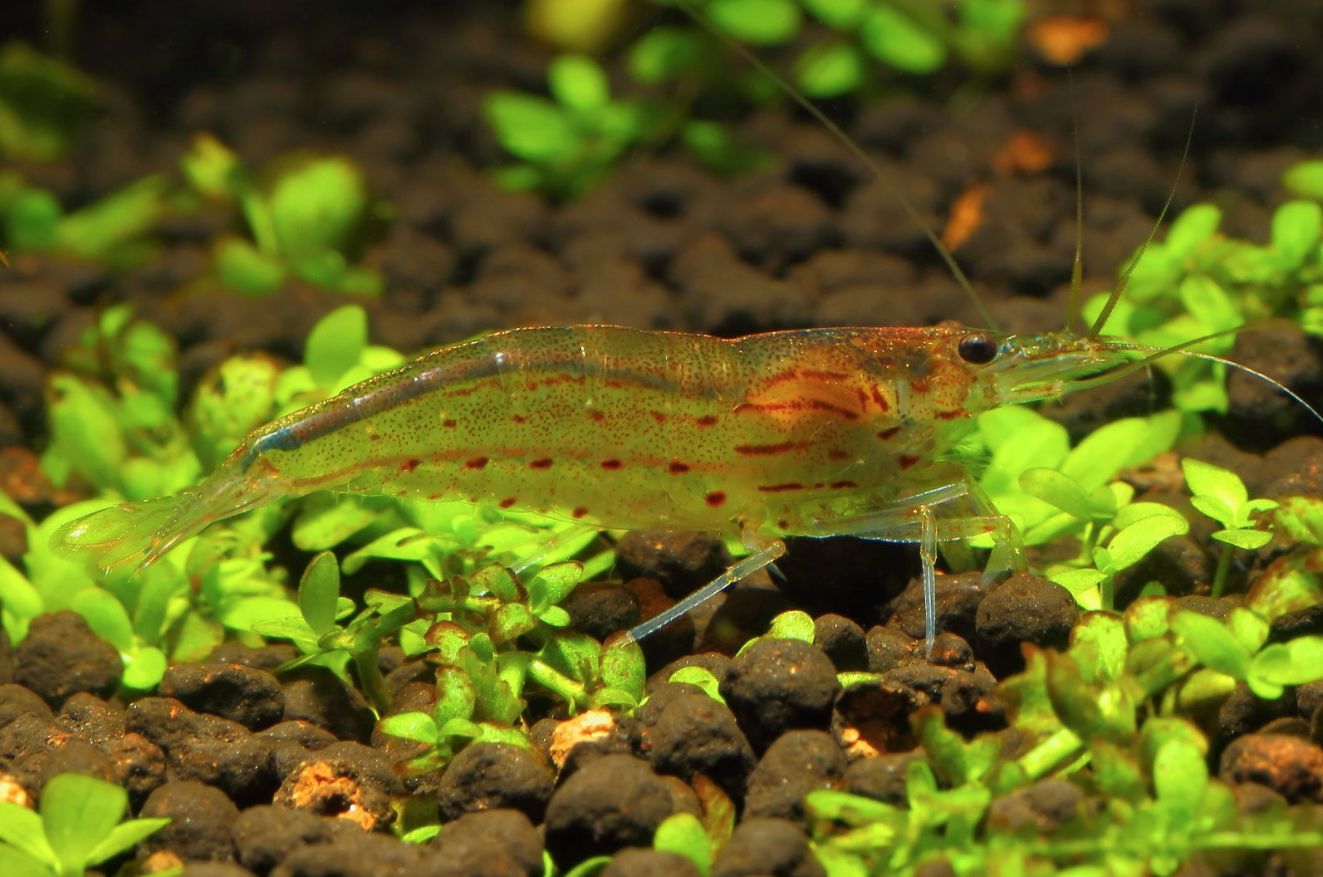
Feeding
The whole day shrimps go around the tank looking for food, touching each stone and leaf, and when they find algae, they cut them with their small chelae.
The best food is specialized food for shrimps, vegetables like cucumber or squash, flakes, pellets, live and frozen food. In general, the shrimps aren’t demanding as for the food, although you should buy food with high content of dietary fiber. They can feed on dead fish, snails. The shrimp likes spending its time on bulbs of moss or sponges of internal water filters. In this case, they feed on fish, food leftovers, and detritus. They don’t eat moss.
Besides, Amano shrimp rather efficiently eats fish food leftovers, especially if you keep some gluttonous fish in the tank. Don’t forget to give the shrimp some additional food, especially if there isn’t much algae and detritus in the tank. Amano shrimp is a rather large one, and it should have a proper diet.
When Amano shrimps are full, they become less active. Usually, they sit on some high spots and expose their body to the water flow rich in oxygen created by the filter. They demonstrate the same behavior after shedding.
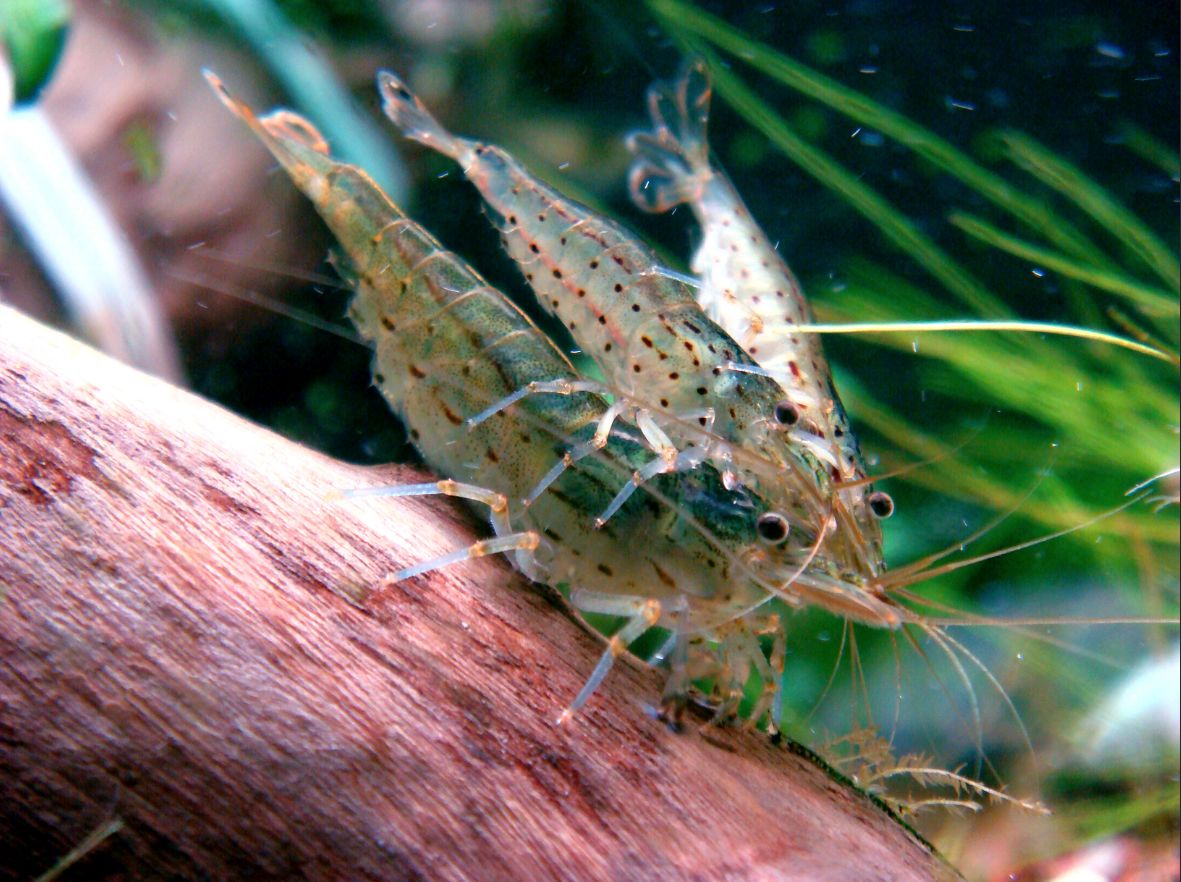
Tank mates
Amano shrimp is peaceful. The shrimp feels comfortable in a common tank. However, they may become prey for some large fishes. Therefore, you shouldn’t keep Amano shrimp with large cichlids (like jaguar cichlid or Texas cichlid, as well as with angelfish, especially if Amano shrimps are little), with large catfish (redtail catfish, striped raphael catfish, sun catfish, upside-down catfish) and goldfishes.
| Fish Species | Size | Temperament | Tank Size (Minimum) | Additional Notes |
|---|---|---|---|---|
| Betta (Siamese Fighting Fish) | Small to medium | Aggressive | 5 gallons | Known to be aggressive towards shrimp and may hunt them |
| Angelfish (Pterophyllum spp.) | Medium to large | Semi-aggressive | 30 gallons | Can see shrimp as food and may prey on them |
| Dwarf Gourami (Trichogaster spp.) | Small to medium | Semi-aggressive | 15 gallons | Can be territorial and may harass or nip at shrimp |
| Goldfish (Carassius auratus) | Medium to large | Semi-aggressive | 20 gallons (per fish) | Highly likely to eat shrimp due to their large size and appetite |
| Rainbowfish (Melanotaenia spp.) | Small to medium | Semi-aggressive | 20 gallons | Can be nippy and may harass shrimp |
| Tiger Barb (Puntigrus tetrazona) | Small to medium | Semi-aggressive | 20 gallons | Known to nip at shrimp and may stress or injure them |
| Red-tailed Shark (Epalzeorhynchos bicolor) | Medium to large | Semi-aggressive | 30 gallons | Can be territorial and may harm or stress shrimp |
| Jack Dempsey (Rocio octofasciata) | Large | Aggressive | 55 gallons | Highly aggressive and will prey on shrimp |
| Oscar (Astronotus ocellatus) | Large | Aggressive | 75 gallons | Very large and predatory fish, will eat shrimp |
Amano shrimp gets on well with any small-sized peaceful fishes since they are peaceful themselves, too. However, when feeding, they may steal food from each other and other fishes, which looks rather funny. Nevertheless, you should still keep an eye on them and make sure that every shrimp gets enough food.
| Fish Species | Size | Temperament | Tank Size (Minimum) | Additional Notes |
|---|---|---|---|---|
| Neon Tetra (Paracheirodon innesi) | Small (1.5 inches) | Peaceful | 10 gallons | Active and colorful, should be kept in groups |
| Ember Tetra (Hyphessobrycon amandae) | Small (1 inch) | Peaceful | 10 gallons | Vibrant red coloration, should be kept in groups |
| Green Neon Tetra (Paracheirodon simulans) | Small (1 inch) | Peaceful | 10 gallons | Similar to Neon Tetras, but with a greenish-blue stripe |
| Harlequin Rasbora (Trigonostigma heteromorpha) | Small (2 inches) | Peaceful | 10 gallons | Active and colorful, should be kept in groups |
| Phoenix Rasbora (Boraras brigittae) | Very small (0.8 inch) | Peaceful | 5 gallons | Beautiful red coloration, should be kept in groups |
| Endler’s Livebearer (Poecilia wingei) | Small (up to 1.5 inches) | Peaceful | 10 gallons | Colorful and active, males have striking patterns |
| Celestial Pearl Danio (Danio margaritatus) | Very small (0.75 inch) | Peaceful | 10 gallons | Delicate and colorful, requires well-established tank |
| Otocinclus Catfish (Otocinclus spp.) | Small (1.5 to 2 inches) | Peaceful | 10 gallons | Algae eaters, gentle and non-aggressive towards shrimp |
| Corydoras Catfish (Corydoras spp.) | Small to medium | Peaceful | 20 gallons | Bottom dwellers, gentle and non-aggressive towards shrimp |
Amano shrimp is compatible with the following fishes: guppies, mollies, bristlenose pleco, all cory catfishes, dwarf gourami, even with discus fish, though the latter requires higher tank water temperature than that for the shrimps.
Shrimps themselves aren’t harmful, neither to fishes nor to their juveniles.
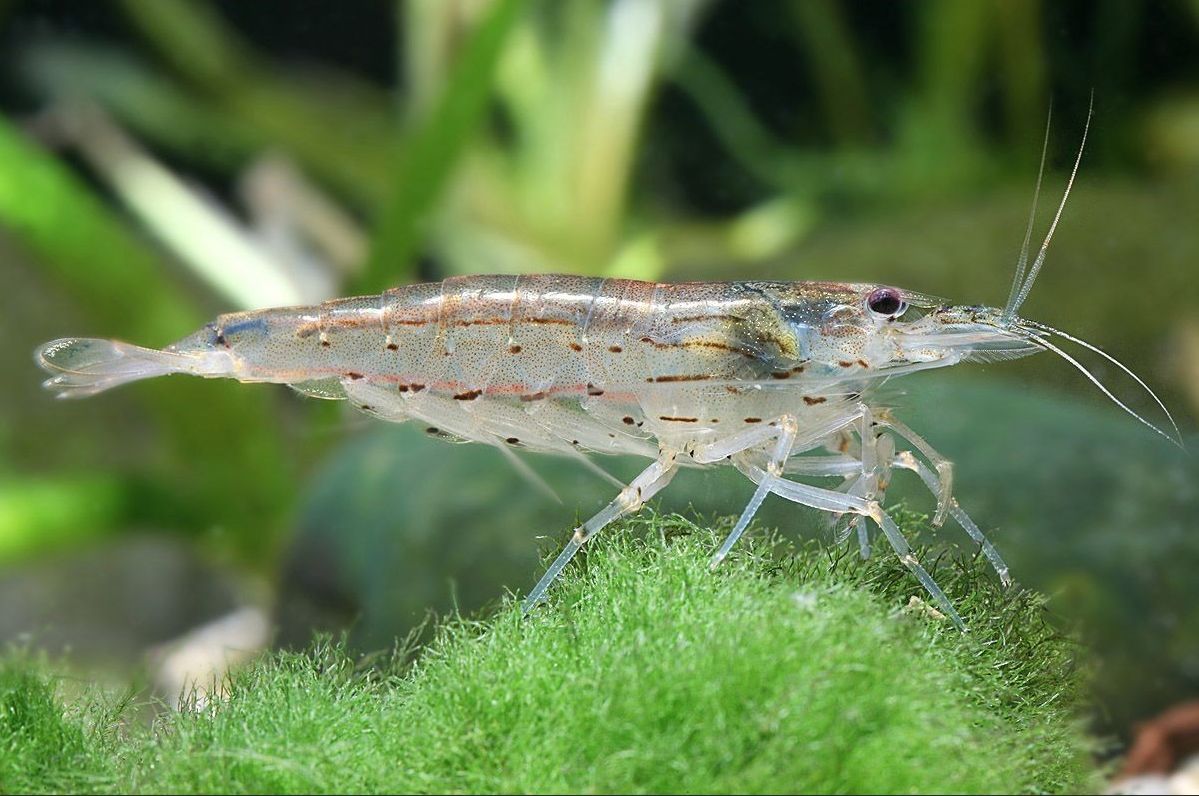
Amano shrimp and cherry shrimp
Can amano shrimp live with cherry shrimp? Despite the contradictory information you may see on the internet about Amano shrimps and cherry shrimps, I have successful experience of keeping them in one tank. I have never seen them eating each other. I can imagine something like this only if Armano shrimp is starving. And again, they have very weak chelae made for cutting algae, not for other shrimps chitinous carapace. So, I’d say you can and should keep these together. They are a good match.
It’s important to note that while Amano shrimp and cherry shrimp may have some similarities, they have different care requirements and may not thrive in the same conditions.
| Characteristic | Amano Shrimp | Cherry Shrimp |
|---|---|---|
| Scientific Name | Caridina multidentata | Neocaridina davidi |
| Appearance | Translucent body with brown or greenish markings | Wide range of colors, including red, blue, yellow, and more |
| Size | Approximately 2 inches (5 centimeters) | Around 1 inches (2.5 centimeters) |
| Behavior | Active foragers, primarily eat algae and organic matter | Active scavengers, can eat algae and detritus |
| Feeding Habits | Strong preference for algae, also eat detritus and small invertebrates | Omnivorous, eat algae, detritus |
| Availability | Widely available in the aquarium trade | Widely available and popular in the aquarium trade |
| Cost | Generally more expensive | Generally more affordable |
| Lifespan | Around 2 to 3 years | Around 1 to 2 years |
| Water Parameters | Prefer slightly alkaline water with moderate hardness | More adaptable to a wide range of water parameters |
| Breeding Challenges | Challenging due to complex larval stages and brackish water requirements | Relatively easy to breed in freshwater aquariums |
Amano shrimp vs ghost shrimp
Amano shrimp (Caridina multidentata) and ghost shrimp (also known as glass shrimp) (Palaemonetes spp.) are both popular freshwater shrimp species in the aquarium hobby. Are Amano shrimp and ghost shrimp the same? No. These are two different shrimp kinds, even though they have a similar appearance. At that, they can live together in one tank.
While they share some similarities, there are notable differences between them:
- Appearance: Amano shrimp have a translucent body with brown or greenish markings, while ghost shrimp are generally more transparent and have a pale, glass-like appearance.
- Size: Amano shrimp are typically larger, reaching around 2 inches (5 centimeters) in length, while ghost shrimp are generally smaller, averaging around 1.5 inches (3.8 centimeters).
- Feeding Habits: Both Amano shrimp and ghost shrimp are omnivorous and will eat algae, detritus, and small invertebrates. However, Amano shrimp have a stronger preference for algae and are often sought after for their efficient algae-eating abilities.
- Cost: Amano shrimp are generally more expensive than ghost shrimp due to their popularity and specialized characteristics, such as their algae-eating abilities.
| Characteristic | Amano Shrimp | Ghost Shrimp |
|---|---|---|
| Scientific Name | Caridina multidentata | Palaemonetes spp. |
| Appearance | Translucent body with brown or greenish markings | Transparent, glass-like appearance |
| Size | Approximately 2 inches (5 centimeters) | Around 1.5 inches (3.8 centimeters) |
| Compatibility | Generally peaceful and compatible with a variety of tank mates | Generally peaceful, but may exhibit aggression and territorial behavior |
| Behavior | Active foragers, primarily eat algae and organic matter | Scavengers, opportunistic feeders |
| Feeding Habits | Strong preference for algae, also eat detritus and small invertebrates | Feed on algae, detritus, and small invertebrates |
| Cost | Generally more expensive | Generally more affordable |
| Lifespan | Around 2 to 3 years | Around 1 to 2 years |
| Breeding Challenges | Challenging due to complex larval stages and brackish water requirements | Can breed in freshwater aquariums |
Gender differences: male vs female
Females have their first line of spots on the abdomen transferred into small lines, but male shrimps still have spots there. A shrimp male is smaller than a female. It is about 1.5 inches large (3.5-4 cm). The female shrimp grows to become a little larger – up to 2 inches (4-5 cm).
If you see not uniformly spread red-cinnamon round spots on the shrimp body sides – this is definitely male. A mature female has pronounced long pleopods on its abdomen.
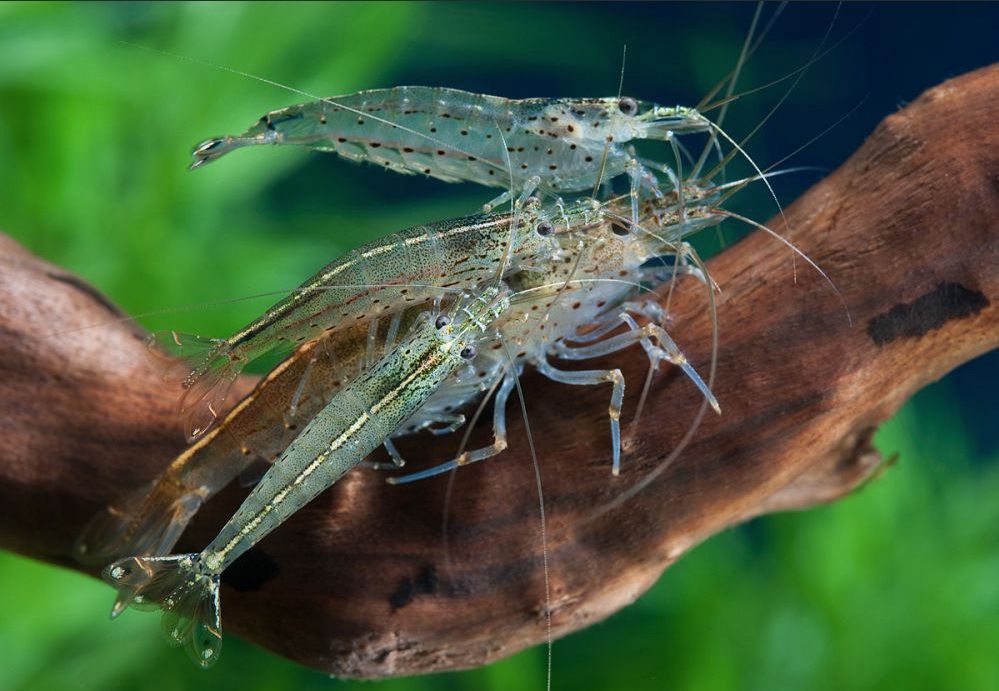
Breeding
Breeding in vitro was considered impossible until recently. There was some information about its successful breeding, but later it turned out to be some other shrimp similar to Amano one. I’ll try to describe in maximum detail the proven technology of Amano shrimp breeding.
Wild breeding
The shrimp lives in rivers and streams that flow into the sea. Unlike red cherry shrimp, whose eggs hatch to show small shrimps looking like the adult ones, Amano shrimp hatches as larvae. They roll to brackish waters and live there for 3-6 weeks, filter plankton unicellular algae, and pass through several steps of development up to the last one. Then small shrimps go to freshwaters where they will live during their whole life. They become reproductive in about 6 months since they hatch.
To achieve success in Amano shrimps breeding, you should take the shrimp larvae and then the juveniles through the stages of water salinity, corresponding to their migration through different kinds of water in the wild.
Amano shrimp breeding in a tank
A female ready for spawning releases pheromones in the water to attract males. You can see it by observing males swimming around the tank and looking for the female. These shrimps actively mate in the tank, and female shrimps carry “bags” with eggs on them. According to approximate calculations, the number of eggs each female shrimp may carry varies from 500 to 1000. The female shrimp carries eggs for 3 and up to 5 weeks. During this period, it tries to stay at spots with high oxygen content, and it cleans the eggs regularly. Right 3-4 days before hatching, the eggs change their color – it becomes obviously brighter.
The female shrimp throws away not fertilized or dead eggs right away.
Eggs incubation by the female
To follow the order of events, we should start with the breeders life. So, I have a small tank for them where 20 females and about 5 males constantly live. There is no bottom substrate in the tank. This is an important aspect since I didn’t succeed in achieving proper eggs incubation in tanks with substrate: the eggs constantly died. In the worst-case scenario, there were no live eggs left in a week. In the best case, by the end of the incubation time, I obtained about 100 larvae, although, in the beginning, the clutch was 500 – 1000 eggs.
In the tank, I have a filter and an aerator. There are many plants and snags in it. The food I use is pellets for shrimps and live blood worms. I often perform water renewal: about 100% once a week or 50% twice a week with full bottom cleaning. Tank water temperature is 22-26 °C depending on the season. I use tap water with a 9-12.
Eggs develop at a different speed. In the clutch, eggs on the edge get more oxygen. The larvae start to appear since the 3rd week of incubation, about 5-10 larvae in a day. And by some moment, most of them start to swim. This is natural since, in the wild, they get to the sea faster if they hatch after the rainy season. However, sometimes hatching is provoked by the female, namely, by her shedding.
Sometimes they remove the female from the community tank after the 3rd week of incubation. Usually, right after this, due to the water renewal, half of the larvae start to swim, and the rest catches up with them in 1-2 weeks.
Some aquarists don’t trust their skills in catching larvae. Therefore they keep the female in a separate tank before the larvae appear, then they remove her and salt the water.
I remove most of the water using a tube with a sieve and pour the rest of the water with larvae into the ‘sea’ I’ve prepared. Of course, this is just one of the possible options for removing the larvae into brackish water. The importance of the gradual transition of the larvae into brackish water is overestimated.
Identifying the larvae
If you don’t use a magnifying glass, the larvae look like little lines about 1.8 mm long a bit thickened on one end. The thin end (the tail) is usually directed to the light. They move in a combination of smooth movements and leaps. I regularly check if they are present in a tank with breeders. Once their number essentially grows, I start gathering them. The way of the larvae gathering described above allows adding larvae into the sea tank as many times as you need.
Water salinity
Recommended water salinity for successful Amano shrimp breeding is 30-35 ppt. They do not stand it higher than 40 ppt. I start with 32 ppt. It is better to start with the salinity level lover than 35 ppt since it is easy to fail with adding the water to compensate for the evaporated amount.
Using edible salt or bath salt is a fail in this case. Usually, it is safe to use branded salt mixtures for sea life aquariums. Don’t listen to those who say that you should prepare the sea tank in advance. Once you dissolve the salt, the water is ready for shrimps larvae.
I use a refractometer to measure the water salinity, while those who don’t have such a device should control the water level in the ‘sea’ using the mark on the wall and avoid water spilling during aeration.
Feeding the larvae
I’d say that food is the main ingredient of success here. There are two options here. The first is using specialized food about 15 μm large. The advantage of artificial food is that you can start using it when you want without any preparations. The disadvantage is the necessity of dose control and frequent water renew and spending the salt, which is not cheap.
Another way is using live salt-water phytoplankton. It is enough to put it in the tank once, and it starts breeding quite quickly. The risk of spoiling the water is minimal. However, there may be the case when it breeds so much that the water will be very dirty. Since phytoplankton is live and it produces waste products as well.
The disadvantage of using live food is that you should get it in advance. Live brine shrimp nauplii won’t do since they are too large, and they grow faster than the shrimps larvae and pollute the tank water a lot.
It is hard to say which of the two approaches is the most popular now. It seems to me that live phytoplankton became unpopular due to the accidental success of this approach. Phytoplankton was obtained in a ‘wild way,’ and its species composition may not be stable, while not all of them are good for the shrimps larvae. I can call it luck when after many failures, I bought salt-water flagellates Tetraselmis. This is a generic name, the name of the specific kind is under question.
Except for it is eatable for the shrimps larvae, it has the following advantages: it breeds fast in fertilized water ( as a rule, faster than it is eaten), and it can relatively easily be distinguished from other plankton kinds. The latter is extremely important since avoiding the plankton species you don’t need is possible only by maintaining the sterility, which is expensive and challenging.
Transition to freshwater
In about three weeks, the most developed larvae start transforming into shrimp juveniles. The juvenile’s behavior completely differs from that of the larvae. The latter are more likely to lay on the tank bottom, while the juveniles sit like all crustaceans and insects. The larvae swim in any direction, while the juveniles swim only forward. The juveniles are colored brick-red as the larvae at first, and then they become completely transparent.
Nature calls the juveniles to freshwaters. In case of abrupt change of tank conditions, especially water salinity, they start swimming chaotically around the tank. Since this moment, you should reduce the water salinity. But don’t hurry to demineralize the water since the larvae can more or less stand the salinity decrease closer to the end of its development. At earlier stages of development, almost all larvae die because of the salinity level decrease. If accidentally, the water salinity rises higher than 35 ppm due to its evaporation, the process of getting back to the initial salinity level should be very slow.
How to demineralize the water quickly? I’ve read that the juveniles can stand an immediate transferring to fresh water. But almost any aquarist knows the rule – change the parameters gradually to be on the safe side. This is what I do because the juveniles, once they feel the freshwater, start looking for a way out from the sea. This is why I pour fresh water far from the walls. All water renewals are performed with a drop bottle for 6-12 hours to smoothen possible abrupt changes of the water parameters.
In 4-6 weeks, about 95% of the larvae become small transparent shrimps, 90% of brackish water is renewed. The poured volume is filled with fresh water from the plant tank during 2-4 hours. The next day, 100% of the water is renewed, and after this, small Amano shrimps 5-7 mm long are ready to go to the community tank.
Sources: